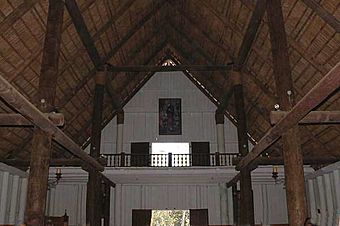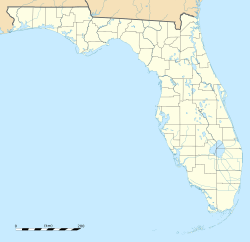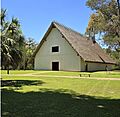Mission San Luis de Apalache facts for kids
|
San Luis De Talimali (formerly San Luis de Apalache)
|
|
 |
|
| Location | Leon County, Florida, USA |
|---|---|
| Nearest city | Tallahassee, Florida |
| NRHP reference No. | 66000266 |
Quick facts for kids Significant dates |
|
| Added to NRHP | October 15, 1966 |
| Designated NHL | October 15, 1966 |
Mission San Luis de Apalachee (also known as San Luis de Talimali) was a special place where Spanish people and Apalachee Indians lived together a long time ago. It was built in 1656 by Spanish Franciscan priests in what is now Florida. The mission was about two miles west of where the Florida Capitol Building stands today in Tallahassee.
This mission was part of Spain's plan to settle the Florida area. They also wanted to teach the Timucuan and Apalachee Indians about Christianity. Mission San Luis lasted until 1704. At that time, it was emptied and burned down. This was done to stop enemies, like Creek Indians and people from South Carolina, from using it.
The land where the mission once stood was named a National Historic Landmark in the United States on October 15, 1966. This means it's a very important historical site. The State of Florida bought the land in 1983. For the next 15 years, experts studied the area to learn more about its past.
In 1998, a project started to rebuild some of the mission's old buildings. These new buildings look like the originals, based on what archaeologists found. Today, Mission San Luis is a living-history museum. Visitors can see reconstructed Apalachee and Spanish buildings and learn about life there long ago.
Contents
The Apalachee People and Early Contacts
The Apalachee people were one of the strongest and wealthiest groups in Florida. They were also the largest native population in Florida. They were part of the Mississippian culture, known for building large mounds of earth. The Apalachee had well-organized ways of running their communities and religious practices.
First European Visitors
In 1528, a Spanish explorer named Pánfilo de Narváez was the first European to visit the Apalachee area. He set up camp near what is now St. Marks. Later, in 1539, another explorer, Hernando de Soto, spent the winter in the Apalachee capital, Anhaica. This is where the first Christmas in North America was celebrated.
In 1607, some Apalachee Indians asked for priests to visit. The first priests came in 1608. The Apalachee formally asked for a mission in 1612, but Spain didn't agree right away. By 1625, the Apalachee began sending food to St. Augustine. St. Augustine was a main Spanish city in Florida. The Spanish needed the Apalachee's help because their land was fertile and had many people who could work.
Starting the Mission
In 1633, two priests, Pedro Muñoz and Francisco Martínez, began a mission in the Apalachee area. They did this because Apalachee chiefs asked them to. By 1638, a few Spanish soldiers came to explore and buy food for the governor. There is no sign that a fort was built at that time.
Life Under Spanish Influence
From 1645 to 1651, Spanish soldiers lived on the eastern edge of the Apalachee area. These soldiers and a deputy governor left in 1651 but returned in 1654.
In 1656, Spanish leaders decided to build their main western base on a high hill. This was a good spot for defense. The people living at the first San Luis mission moved to this new spot in 1656. The number of soldiers grew to 12. The Apalachee chief at San Luis promised to build a strong blockhouse for them. However, other Apalachee leaders disagreed, saying six soldiers would be enough. The Spanish governor wanted to build a bigger fort, but the Apalachee people stopped this plan for many years. In 1675, the blockhouse was described as a "fortified country house." Between 1656 and 1680, the number of soldiers changed, from 12 to 25 men.
Apalachee Contributions
Apalachee men and women were excellent farmers. They grew much of the food for San Luis. They also grew food to send to places like St. Augustine and Havana. The Apalachee also did most of the building work. This included helping to build the Castillo de San Marcos, a large fort. This was part of a system called repartimento. It was a Spanish rule that made native people work for the Spanish. These tasks often took the Apalachee away from their own farms and homes for months.
The first deputy governor, Claudio Luis de Florencia, arrived in 1645. He lived with his family at the old San Luis. By 1675, more than 1,400 Apalachee and several hundred Spanish people lived at San Luis. There were not many Spanish women, so Spanish soldiers often married Indian women. This helped to spread Christianity and Spanish customs among the native people. While other Apalachee missions saw their populations shrink, San Luis grew.
Mission Buildings and Their Purpose
The buildings at San Luis included homes for both Spanish and Apalachee people. There was also a Franciscan Church and a Spanish fort. A very important building was the native Council House. This was the largest known historic Indian building in the southeastern United States at the time. It could hold between 2,000 and 3,000 people!
Changes to the Fort
In the early 1680s, the old blockhouse was taken down. A temporary barracks was built in its place. The number of soldiers then grew to 40, and sometimes even more for special trips.
In 1688, a fort called San Marcos de Apalache was built at St. Marks. The wood for it came from San Luis. However, work stopped when skilled workers were sent to build another fort in 1689. This new fort had 20 soldiers and 20 Apalachee warriors.
From 1695 to 1697, a new blockhouse was built at San Luis. By April 1696, it was almost finished, but work stopped for spring planting.
In 1698, the Apalachee people at San Luis became upset. Spaniards took some of their houses and land. They also took wood meant for church repairs and made Indians build houses for them.
The End of the Mission
In October 1702, after a battle, efforts began to turn the blockhouse into a proper fort. It was planned to have a strong fence, walls, and a dry ditch around it. This fort was finished in 1703, even with a serious sickness spreading. By the end of July 1704, many attacks by English settlers and their Creek allies had happened across the Apalachee lands. The Apalachee people decided they no longer wanted to fight with the Spanish. They moved away to the west, east, and north. Some went willingly, while many others were captured by the English. When San Luis was left empty, the Apalachee and Spanish people together burned the fort and the entire village to the ground.
Rebuilding the Past
Starting in 1996, architects began designing the reconstruction of many mission buildings. They used archaeological finds and historical records to guess how the buildings originally looked. The buildings that have been rebuilt include the Church, the Convento (where priests lived), the Council House, the Chief's House, the Fort and Blockhouse, and a typical Spanish House. Many of these new buildings stand exactly where the old ones were.
Mission San Luis Today
Mission San Luis is now a living history museum. It has a gallery with artifacts found at the site. Visitors can also explore many reconstructed buildings. People dressed in historical clothes act as interpreters, showing what life was like long ago. The site covers 64 acres and tells the story of the mission and the people who lived there.
See also
 In Spanish: San Luis de Apalache para niños
In Spanish: San Luis de Apalache para niños






